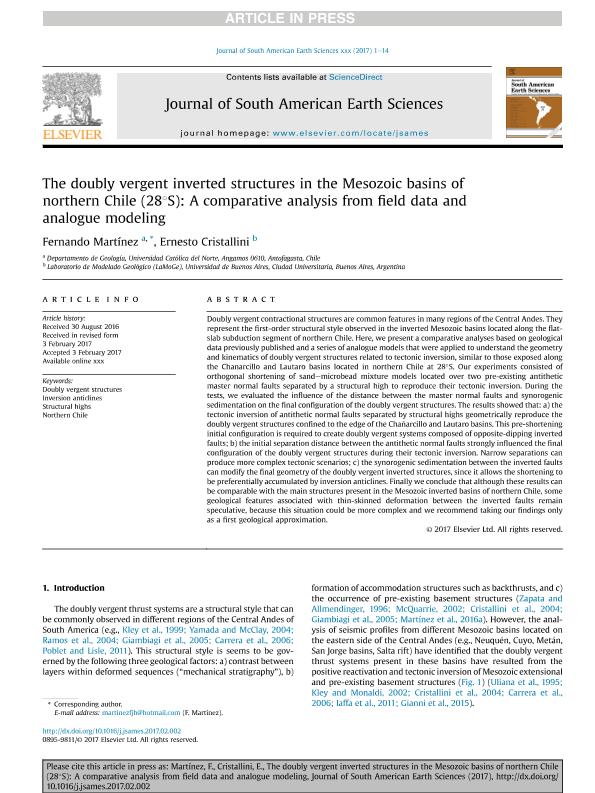Mostrar el registro sencillo del ítem
dc.contributor.author
Martínez, Fernando
dc.contributor.author
Cristallini, Ernesto Osvaldo

dc.date.available
2017-06-12T20:56:47Z
dc.date.issued
2016-08
dc.identifier.citation
Martínez, Fernando; Cristallini, Ernesto Osvaldo; The doubly vergent inverted structures in the Mesozoic basins of northern Chile (28°S): A comparative analysis from field data and analogue modeling; Pergamon-elsevier Science Ltd; Journal of South American Earth Sciences; 8-2016
dc.identifier.issn
0895-9811
dc.identifier.uri
http://hdl.handle.net/11336/18039
dc.description.abstract
Doubly vergent contractional structures are common features in many regions of the Central Andes. They represent the first-order structural style observed in the inverted Mesozoic basins located along the flat-slab subduction segment of northern Chile. Here, we present a comparative analyses based on geological data previously published and a series of analogue models that were applied to understand the geometry and kinematics of doubly vergent structures related to tectonic inversion, similar to those exposed along the Chanarcillo and Lautaro basins located in northern Chile at 28°S. Our experiments consisted of orthogonal shortening of sand-microbead mixture models located over two pre-existing antithetic master normal faults separated by a structural high to reproduce their tectonic inversion. During the tests, we evaluated the influence of the distance between the master normal faults and synorogenic sedimentation on the final configuration of the doubly vergent structures. The results showed that: a) the tectonic inversion of antithetic normal faults separated by structural highs geometrically reproduce the doubly vergent structures confined to the edge of the Chañarcillo and Lautaro basins. This pre-shortening initial configuration is required to create doubly vergent systems composed of opposite-dipping inverted faults; b) the initial separation distance between the antithetic normal faults strongly influenced the final configuration of the doubly vergent structures during their tectonic inversion. Narrow separations can produce more complex tectonic scenarios; c) the synorogenic sedimentation between the inverted faults can modify the final geometry of the doubly vergent inverted structures, since it allows the shortening to be preferentially accumulated by inversion anticlines. Finally we conclude that although these results can be comparable with the main structures present in the Mesozoic inverted basins of northern Chile, some geological features associated with thin-skinned deformation between the inverted faults remain speculative, because this situation could be more complex and we recommend taking our findings only as a first geological approximation.
dc.format
application/pdf
dc.language.iso
eng
dc.publisher
Pergamon-elsevier Science Ltd

dc.rights
info:eu-repo/semantics/openAccess
dc.rights.uri
https://creativecommons.org/licenses/by-nc-sa/2.5/ar/
dc.subject
Doubly Vergent Structures
dc.subject
Inversion Anticlines
dc.subject
Northern Chile
dc.subject
Structural Highs
dc.subject.classification
Geología

dc.subject.classification
Ciencias de la Tierra y relacionadas con el Medio Ambiente

dc.subject.classification
CIENCIAS NATURALES Y EXACTAS

dc.title
The doubly vergent inverted structures in the Mesozoic basins of northern Chile (28°S): A comparative analysis from field data and analogue modeling
dc.type
info:eu-repo/semantics/article
dc.type
info:ar-repo/semantics/artículo
dc.type
info:eu-repo/semantics/publishedVersion
dc.date.updated
2017-06-12T20:04:06Z
dc.journal.pais
Estados Unidos

dc.description.fil
Fil: Martínez, Fernando. Universidad Catolica del Norte; Chile
dc.description.fil
Fil: Cristallini, Ernesto Osvaldo. Consejo Nacional de Investigaciones Científicas y Técnicas. Oficina de Coordinación Administrativa Ciudad Universitaria. Instituto de Estudios Andinos "Don Pablo Groeber". Universidad de Buenos Aires. Facultad de Ciencias Exactas y Naturales. Instituto de Estudios Andinos ; Argentina
dc.journal.title
Journal of South American Earth Sciences

dc.relation.alternativeid
info:eu-repo/semantics/altIdentifier/url/http://dx.doi.org/10.1016/j.jsames.2017.02.002
Archivos asociados
